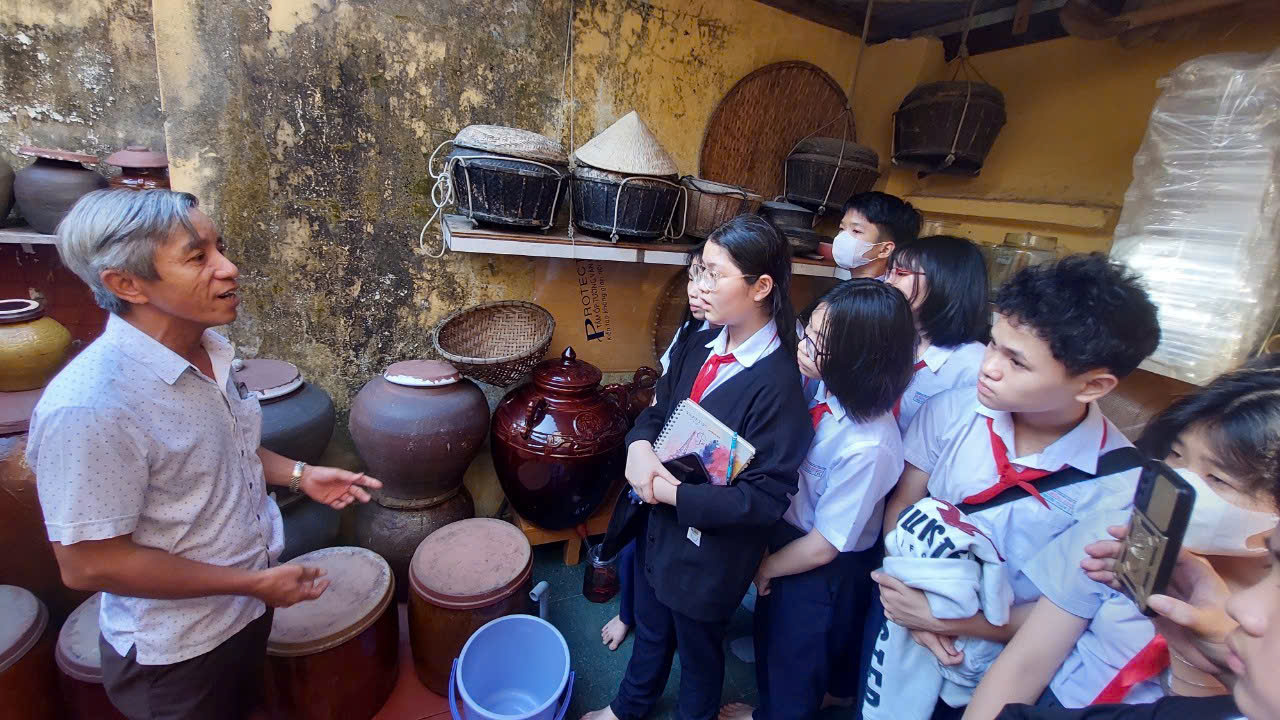Special fish sauce enthusiast
There are people who choose a career for life, while others follow paths set by fate. In reality, some jobs aren't assigned by society; rather, they are embraced by the individual. In Viet Nam, fish sauce is a staple, but few ponder the makers behind it, and even fewer are truly passionate about it. Mr. Huynh Van Muoi, from Man Thai, Son Tra, is one of the few who is utterly devoted to this unique, pungent liquid.
 |
| Many groups of pupils have come to listen to Mr. Muoi tell the story of the sea and sky. Photo: Mr. Muoi |
Fish sauce and fermented fish sauce
Muoi’s love for fish sauce is sincere and perhaps even a little romantic. He fell for it during childhood, but it wasn’t until later in life that he fully immersed himself in it as a profession. Many of us have eaten fish sauce, but it wasn’t until I met him that I understood the difference between nuoc mam (fish sauce) and mam nuoc (fermented fish sauce).
‘Nuoc mam’ primarily uses water as its base, whereas fermented fish sauce is all about the fish, and there are many kinds, mam ca, mam ruoc, and others. Industrially produced ‘nuoc mam’, often made with chemicals, has unfortunately overshadowed traditional methods, where sauces were crafted from anchovies or mackerels caught in-season, offering an authentic taste.
The ocean holds countless species, including various types of anchovies. Muoi explains that there are over ten types, including com than (black anchovies), and com do (red anchovies), named for their distinctive long tails. Among them, com than is the most prized, known for its significant size and flavour, making it the top choice for fish sauce production.
Stepping into Muoi’s modest home, two things stand out: its cleanliness and his collection of maritime artefacts. As a fish sauce maker, he has several earthenware jars, ranging from large 300-litre vats to smaller ones. These jars are lined neatly, each with a spigot at the base, methodically dripping the pure essence of the sea.
Fermenting fish can produce strong odours, but in Muoi’s space, there’s barely a trace. His attention to detail extends even to how he describes serving the sauce: dipping slices of pork belly into a bowl of fish sauce with a chilli, complemented by fresh herbs and rice. His descriptions alone leave you salivating.
Muoi’s passion for his craft is unwavering. He firmly believes that his dedication to the sea and its bounty will be appreciated by others. He likens fish sauce to life itself - unpredictable yet enduring.
A Vietnamese staple
Almost every type of fish from the sea can be used to make fish sauce, though anchovies, mackerel, and tuna are the most common. I’ve sampled some of Muoi’s creations, including his mam tep (fermented shrimp), which is particularly refreshing. Fresh shrimp, carefully cleaned and mixed with the perfect balance of salt, ginger, and galangal, ferments quickly, yielding a ready-to-eat delicacy within days.
One lesser-known variety is mam ca nuc (fermented mackerel), which was once a household staple, especially during the rainy season. I still remember steaming the mackerel, spiced with peppercorns, and pairing it with boiled greens - simple yet delightful.
Muoi is now systematising his knowledge, refining the processes for creating these traditional fish sauces. It’s common knowledge that ‘nuoc mam’ is uniquely Vietnamese, a part of the national identity. In fact, “Le Nuoc Mam” and “Ao Dai” have been included in French and American dictionaries for decades.
 |
| Mr. Muoi has a deep, sincere passion for fish sauce. Photo: Mr. Muoi |
Preserving the tradition
Muoi is quietly building what could be considered a maritime museum. From old receipts for diesel engines from the 1950s to gas lanterns used for fishing, he’s determined to recreate the history of this trade. His aim is to help the younger generation appreciate not just the sea’s bounty, but the intricate labour that goes into making fish sauce.
While fish sauce might not appeal to everyone, the knowledge of fishing and fish processing is a fascinating subject. Muoi often receives visitors from afar who are keen to learn about his craft. His knowledge might not be academic, but it’s extensive, practical, and compelling.
Every now and then, he shares his insights with groups of students, most of whom have never experienced life at sea. For these young minds, it’s not just about learning to appreciate fish sauce but also understanding the broader picture of life on the ocean.
Sadly, the craft of fishing is slowly fading. In the past, during the lunar new year, boat owners would host feasts for their crew, who were more than just employees; they were a family. Today, that sense of community is dwindling. Fewer young people are choosing to follow in their parents’ footsteps, and fewer women are inclined to carry baskets of fish to the markets.
Muoi’s commitment to preserving these traditions is personal. He’s aware of the challenges in keeping these customs alive, from the tools used in fishing to the knowledge required to make traditional fish sauces.
The road to preserving a craft is long, but Muoi has already begun his journey. Piece by piece, he is collecting artefacts and tools from the fishing industry, determined to tell the story of the sea. He hopes that, one day, there will be enough space and funding to create a fully-fledged museum dedicated to the craft he holds so dear.
While fish sauce might not be to everyone's taste, the rich history behind its creation, and the stories of those like Muoi, offer a captivating glimpse into a way of life that is slowly disappearing. Through his efforts, he hopes to keep the spirit of the sea alive, not just for his generation but for those yet to come.
Reporting by THUC NHAN - Translating by TRUC VY








